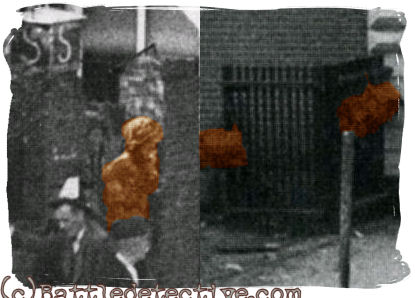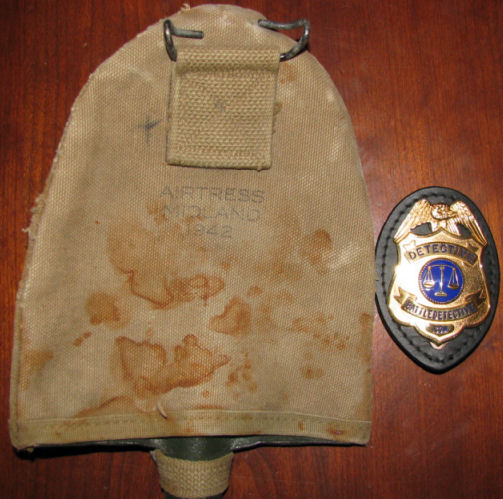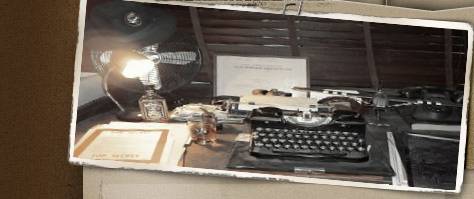|
Investigation:
James L. Davidson
The combination of the name and the
ASN lead Battle Detective Tony to conclude that this pouch belonged to James L. Davidson.
He was a member of the demolition section of
"HQ.-"Co./506th of the 101st
Airborne Division; a colorful group
of soldiers with their own
perception of military discipline.
These men were known as the
"Filthy 13". Below is a photograph of
some of the "Filthy 13" in their base camp
in England:
(Click on the image
to enlarge)
It is also known that Davidson died
in the night of the
19th of September 1944. That night,
the city of Eindhoven - just
liberated a day earlier by elements of the 101st
Airborne Division- was
strafed and bombed by the German
Luftwaffe. Members of "HQ-"Co./506th
were billeted in the downtown area
of Eindhoven and it was on Stratums
Eind that Davidson met his death.
Battle Detective Tony
has done research to the
circumstances of Davidson's death
and he has found out that this must have happened during a strafing
run of one the Luftwaffe's fighter
bombers on Stratums Eind. In 1944
the Dommel River's course was
different than it is today. Then it
meandered in such a way that Stratums Eind
crossed it twice. There
is information that Davidson died in
between the two bridges across
the Dommel River on Stratums Eind.
Chain of Custody
Battle Detective Tony wrote down the name of the
seller of the pouch and in a
subsequent phone call she told him that
the pouch was from the estate of a
cousin of hers. In a garage or shed
that she is clearing, she found the
pouch. Also from that estate is a
World War Two era magazine pouch for
the .45-calibre Thompson Sub Machine
Gun. We purchased that item also. This piece of equipment,
however, was not personalized.
We are currently investigating
for more details of this cousin.
Davidson's death
Below are two photographs of
Stratums Eind taken in September
1944. The first picture is taken on
the 18th and shows tanks of the
British XXXth Corps entering
Eindhoven from the South. The second
photograph is taken two days later; on
the 20th. This picture is in stark
contrast with the one taken two days
before. It shows an almost empty
street and the damage done by the
German Luftwaffe.
(Click on the image
to enlarge)
A closer analysis of both
pictures reveals an American
paratrooper in the first picture and
three M1936 musette bags - typically
used by US Paratroopers - suspended
from a gate.

The
location is an air raid shelter
North of both Dommel River Bridges.
The photographer stood in a second
floor window almost on top of the
Northern Dommel River bridge. In the
second picture a pole is visible in
front of the gate with the musette
bags. Until the day before, it held
up the sign with "Schuilplaats" or
"Air Raid Shelter" which can be seen
in the picture taken on the 18th.
Troopers of "HQ-"Co./506th may have
been billeted here. It is our
theory that during the
bombing raid Davidson was South of
this location when he got killed.
The staff of "Playerz, Dinner &
Dance" on Stratums Eind, showed
Battledetective.com all the
courtesies for taking a comparison
photograph from the same window as
from which the September 1944
photo's were taken. This is the same
location today:


Jake McNiece's account
101st airborne Division
veteran Jake McNiece was a member of
the "Filthy Thirteen".
In his book with that name are
several references to Sgt.
Davidson's death:
On page 124: "[Lieutenant
Eugene Dance] said, We've got
orders to hold these bridges. That's
what we are going to do."
I again hollered back at the
boys, "You better get out of here,
if you want out! They are going to
bomb us here in a minute."
He said: "I'll court-martial any
man in the morning who leaves his
position."
I kind of grinned, "You won't be
there in the morning if you stay on
these bridges."So I yelled, "All you
guys who want out of there come on
out now! I'm leaving. We'll get out
of here about a block from this
place and find cover." So we did.
The lieutenant went on down to
the second bridge where Myers's
section was. Davidson also came
over. Bill Myers and Jim Davidson
were trying to get him to quit and
withdraw to some shelter. Dance was
sticking to his ground. Those bombs
that came in blew up Myers's bridge
and killed both of those sergeants."
On page 265: "There is some
confusion as to how Davidson and
Myers actually died.
[...]
Herb Piece was on outpost duty in
Davidson's section. Davidson yelled
at him, "Let's get out of here!"
They started out of the building for
an air raid shelter with Myers in
the lead. When Herb saw the bombs
falling, he turned back into the
building but the blast killed
Davidson.
CPL Tom Young said there was a
shelter near each bridge. When the
Messerschmitts came, he could see
what they were going to do. He told
his squad -Armando, Marquez, Steve
Kovacs and Frank Kough- to get into
the shelter. He told Bill Myers and
Jim Davidson to get in there too but
they just stood out in the open. The
planes dropped three bombs. A piece
of shrapnel about the size of an egg
hit Myers in the kidney and another
piece hit him on the back of the leg
slicing the muscle in two. Myers
fell on Tom who carried him into the
shelter. The planes returned on a
strafing run and set the convoy of
trucks ablaze.
Davidson stood there shooting at
them with his Thompson submachine
gun when he was hit. The rounds had
taken his legs off.
[...]
From there [an alley way]
Jack ran around trying to find an
air raid shelter. He came upon the
bodies of Davidson
and Myers. They were not more
than three feet apart. He could see
from the bullet holes where he
believed Davidson had been killed by
strafing while standing against a
wall. When he picked Jim up, Jack's
fingers went right through the back
of Davidson's head. A round had
blown his brains out. Myers had his
legs blown off but was still alive.
Jack said he carried Myers down into
the air raid shelter where he found
Armando Marquez.
Mike Marquez had dug a foxhole
over in Jake's sector. His brother,
Armando, was on the next bridge.
Mike did not want him anywhere near
because he would have worried about
taking care of him.
[...]
After the bombing, Mike ran over
to check on his brother. Armando had
brains and blood dripping from under
his helmet. After a few words with
him, Mike realized that Armando was
all right. He had evidently put on
Davidson's helmet."
These graphic descriptions of
Davidson's wounds are in a bit of a
contrast with the remarks in his US
Army Disinterment Directive. In 1948 Davidson's
remains were disinterred from the
temporary
US Army Cemetery in Son, Holland
and shipped to his family in
Virginia. This agency obtained a copy of
the file. Under "Condition of
remains" the directive states:
R/TIBIA & FIBULA FRACT, BODY
COMPLETE,
ADVANCED STAGE OF DECOMPOSITION,
R/RADIUS
& ULNA FRACT.
(click to open the
1948
Disinterment
Directive)

This may mean that Davidson's right
arm and leg were shattered by the
impact of the Luftwaffe's shrapnel
or bullets to a point that these
extremities where almost or
completely severed from the body.
The record does not state that BOTH
his legs where separated from the
body. Witnesses in the accounts in
the "Filthy 13" book, may have seen
Davidson's arm and leg severely
wounded and in the confusion of the
bombing raid concluded they saw both
his legs blown off. Whatever the
truth is, Davidson must have
sustained extensive wounds, loosing
a considerable amount of blood.
Forensic analysis
The damage to the pistol belt hook
and the reddish stains suggest trauma inflicted
on the
wearer.
On the 5th of March 2008, this lead
has been investigated by conducting
a tetra base test and by applying a
chemical reagent to determine if the
stains are in fact blood.
Tetra base test
For this test, we used Hemestix(Tm)
plastic test tubes. These tubes
contain two glass vials with the
chemical detection components. To
determine if a suspected substance
is in fact blood, a sample is to be
inserted inside the test tube. The
glass vials are then crushed
allowing the components to mix. The
newly formed substance would color a
sample of actual blood blue.
We obtained a sample from one of the
reddish stains on the pouch with the
use of some distilled water and a
Q-tip. We retrieved a sample that
colored the Q-tip head in the same
color as the stain. From previous
experiences with positive results
from the Hemestix(Tm) tests, we know
that even a sample that is hardly
visible will do.
(Click on the images
to enlarge)
The test did not show positive. A
second Hemestix(Tm) test confirmed
that the stains were not blood
stains.
In our collection we have another
example of World War Two vintage US
Army web equipment with similar
stains.

It is our recent theory that these
stains are in fact caused by either
the effect of moist to the duck
(canvas) material or the presence of
corroding metal in the close
proximity of the object leaking
rusty droplets onto it.
Chemical reagent test
After this test, we applied
BlueStar(Tm) Forensic on the pouch.
BlueStar(Tm) Forensic is a
luminiscent agent which emits a
bright blue light when in comes into
contact with traces of blood. The
chemical showed no positive reaction
on the stain. The metal pistol belt
hook, however lit up in a bright
blue light in the darkened test
room.
(Click on the images
to enlarge)
Possible false positive
validation test
In order to validate this test, we
also applied BlueStar Forensic(tm)
agent on the cover of the T-handle
entrenching tool and on the pistol
belt hook of a canteen cover from
the same era. Also we put four
different first aid pouches, made
during World War Two, to the test.
The reason for this was to rule out
the possibility that most metal
pistol belt hooks with a comparable
history, would react like the hook
on Davidsonís pouch.
After applying the agent on a known
blood stain, the agent was fit for
use. We applied it to all six items.
(Click on the images
to enlarge)


None of them gave a reaction of any
significance to the BlueStar(tm)
Forensic agent.
Combining the written accounts of
Davidsonís death and the results of
our forensic tests, it is our theory
that there is in fact blood on the
pistol belt hook of Davidsonís first
aid pouch; presumably his. |













